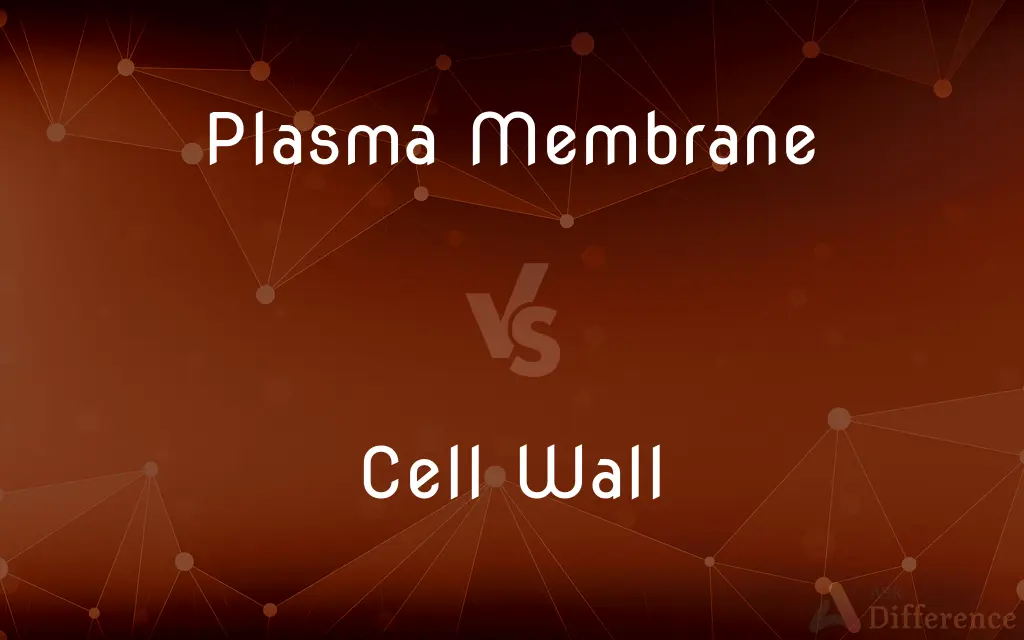Plasma Membrane vs. Cell Wall — What's the Difference?
Edited by Tayyaba Rehman — By Fiza Rafique — Published on January 10, 2024
Plasma Membrane are flexible, selective barrier of cells. Cell Wall is a rigid, protective layer around some cells.

Difference Between Plasma Membrane and Cell Wall
Table of Contents
ADVERTISEMENT
Key Differences
The plasma membrane is a bi-layer of lipids with embedded proteins that encloses every living cell, controlling the movement of substances in and out of the cell. In contrast, the cell wall is a rigid structure that lies outside the plasma membrane, providing support and protection. Notably, while the plasma membrane is essential and present in all cells, the cell wall is found only in plants, fungi, bacteria, and some protists.
The composition of the plasma membrane is mainly lipids and proteins, which allows for flexibility and selective permeability. This structure is crucial for communication and nutrient transport. The cell wall, made primarily of carbohydrates like cellulose in plants, chitin in fungi, and peptidoglycan in bacteria, does not partake in these functions but provides mechanical strength and helps maintain cell shape.
Furthermore, the plasma membrane plays a key role in cell signaling and can be involved in cell-to-cell communication. The cell wall, however, is not involved in signaling but can act as a barrier to pathogens and contribute to the form of the organism by determining cell shape.
In addition to structural differences, the plasma membrane and cell wall differ in their physical properties. The plasma membrane is dynamic, constantly changing shape and composition in response to the environment, while the cell wall is relatively static and does not readily change.
Lastly, in terms of repair and regeneration, the plasma membrane has the ability to self-heal and reassemble if damaged. The cell wall, while robust, can be broken down by enzymes and, once damaged, typically requires the cell to synthesize new components to patch or rebuild the damaged area.
ADVERTISEMENT
Comparison Chart
Presence
Found in all cells
Found only in plants, fungi, bacteria, and some protists
Primary Function
Selective barrier for transport and communication
Provides rigidity, shape, and protection
Composition
Lipid bilayers with proteins
Mostly carbohydrates (e.g., cellulose, chitin, peptidoglycan)
Flexibility
Flexible and self-healing
Rigid and not self-healing
Permeability
Selectively permeable
Permeable but not involved in selectivity
Compare with Definitions
Plasma Membrane
The plasma membrane is the boundary between the cell interior and the external environment.
Damage to the plasma membrane can cause cell death.
Cell Wall
A protective outer layer found in plant, fungal, and bacterial cells.
Antibiotics target the cell wall synthesis in bacteria.
Plasma Membrane
A semi-permeable membrane surrounding the cytoplasm of a cell.
The plasma membrane controls the influx of glucose into the cell.
Cell Wall
An extracellular matrix that determines the shape of the cell.
The cell wall's composition can vary significantly between species.
Plasma Membrane
The plasma membrane is a dynamic structure essential for cellular homeostasis.
The plasma membrane adapts its composition in response to environmental changes.
Cell Wall
The cell wall is a barrier against physical stress and pathogenic organisms.
The cell wall contributes to the plant’s overall defense mechanism.
Plasma Membrane
The plasma membrane is the cell's outermost layer that regulates entry and exit of substances.
The plasma membrane's integrity is crucial for cell survival.
Cell Wall
The cell wall is a rigid layer that provides structural support to some cells.
The cell wall gives plant cells their rectangular shape.
Plasma Membrane
A lipid bilayer with proteins that encapsulate cell components.
The plasma membrane's fluidity allows for the mobility of embedded proteins.
Cell Wall
The cell wall is composed mainly of cellulose in plants, providing rigidity.
The cell wall prevents plants cells from bursting in hypotonic solutions.
Cell Wall
Rare spelling of cell wall
Common Curiosities
What are the main components of the plasma membrane?
Lipids and proteins are the main components.
Is the plasma membrane found in all cells?
Yes, all cells have a plasma membrane.
What is the primary function of the plasma membrane?
It regulates the entry and exit of substances in and out of the cell.
Is the cell wall flexible?
No, the cell wall is rigid.
What is the primary function of the cell wall?
It provides structural support and protection to the cell.
Do all cells have a cell wall?
No, only some cells like plant and bacterial cells have a cell wall.
Can the plasma membrane repair itself?
Yes, the plasma membrane can self-heal after damage.
Does the plasma membrane participate in cell communication?
Yes, it plays a key role in cell signaling.
How does the cell wall contribute to a plant's shape?
It determines cell shape and resists internal turgor pressure.
Can the cell wall protect against pathogens?
Yes, it can act as a barrier to pathogens.
Are the components of the plasma membrane and cell wall the same?
No, the plasma membrane is made of lipids and proteins, while the cell wall is mainly carbohydrates.
How does the permeability of the plasma membrane compare to the cell wall?
The plasma membrane is selectively permeable, while the cell wall is permeable but does not select for specific substances.
What is the cell wall made of in plant cells?
It’s mainly made of cellulose.
Can the cell wall be involved in signaling?
No, the cell wall does not participate in signaling.
Do animal cells have cell walls?
No, animal cells only have plasma membranes and no cell walls.
Share Your Discovery

Previous Comparison
Photic Zone vs. Aphotic Zone
Next Comparison
Gel Filtration vs. Affinity ChromatographyAuthor Spotlight
Written by
Fiza RafiqueFiza Rafique is a skilled content writer at AskDifference.com, where she meticulously refines and enhances written pieces. Drawing from her vast editorial expertise, Fiza ensures clarity, accuracy, and precision in every article. Passionate about language, she continually seeks to elevate the quality of content for readers worldwide.
Edited by
Tayyaba RehmanTayyaba Rehman is a distinguished writer, currently serving as a primary contributor to askdifference.com. As a researcher in semantics and etymology, Tayyaba's passion for the complexity of languages and their distinctions has found a perfect home on the platform. Tayyaba delves into the intricacies of language, distinguishing between commonly confused words and phrases, thereby providing clarity for readers worldwide.
















































